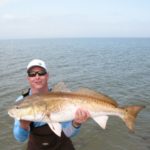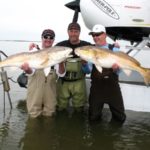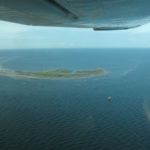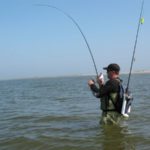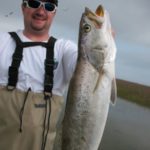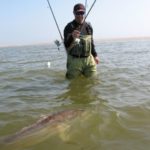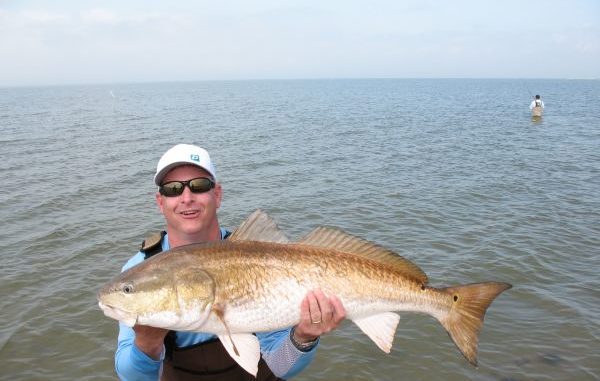
Big reds swarm the barrier islands this month, and here’s what you need to know to get in on the action.
So, I’m at this media event, at Theophile Bourgeois’ lodge in Lafitte. Bourgeois invited all his sponsors and a few media guys to spend a couple nights at his place, where he’d provide food and lodging, give us all a chance to mingle and talk shop, and then pile us into a fleet of bay boats to see if we could do more than talk the talk.
Fishing stories, product discussions and general conversation lasted late into the night between the couple dozen of us there, and after an early breakfast came the boat assignments. Call it the luck of the draw, but my assignment was to take a seat in Bourgeois’ Cessna float plane along with Mercury Marine’s Kevin Brown and Power-Pole’s Robert Shamblin for a flight out to the barrier islands for some March wade-fishing for bull reds.
By 6 a.m. the bay boats were loaded up and pulling away from the dock despite some thick, early fog. They would be fishing a variety of marsh locations for reds and, hopefully, some specks. The fog hung heavy over us, but wasn’t as thick at ground level as it was above us, so the boats could navigate safely. But the airplane was grounded until we got a break in the fog.
A couple hours later, Bourgeois said he had a weather report that the fog was lifting downriver so we should be safe to fly. The four of us squeezed into a very compact cockpit (think 1966 Volkswagen Beetle), and the engine roared to life.
Now these floatplanes are marvelous machines, but roomy they’re not. Rods and reels were squeezed into the cockpit along with the four of us, and whatever else we carried was stowed in a small rear compartment or inside the pontoons. There was no ice chest for fish, so whatever we caught would go into the pontoons for the short flight home.
Once underway it soon became apparent that the fog did not lift downriver and, in fact, seemed thicker and lower than ever. Theophile’s strategy was to fly below the fog, and before long we were circling Breton Island looking for some calm water to land in.
“I always circle the island before I land to look for anything that might be in the water — logs or trash or obstructions of any kind,” he said as the plane slowed to landing speed and splashed down on the surface on the sound side of Breton Island.
We exited the plane single file, as each of us had to shed shoes and don our waders while balancing on the pontoons before stepping off into the cold water.
“The water is still cold in March,” Bourgeois said. “If you’re going to wade-fish, then you definitely need waders. This isn’t really winter anymore, but it isn’t spring yet, either.”
And the water temperature also means it’s OK to sleep in a bit.
“The late start we got this morning isn’t a problem because the water is still pretty cold and the best fishing is between 10 a.m. and 2 p.m. right now, which is the heat of the day,” Bourgeois said. “During that period, these redfish swarm up onto the shallow flats to catch the sun and forage, and that’s when you want to be casting your lure to them.
“But before 10 a.m. and after 3 p.m. the fish move off the sandbars into some deeper water out of our range.”
Once in the water, we spread out and began casting toward the north or Breton Sound side of the island.
Bourgeois keeps his tackle assortment to a minimum. He brings only the glow-colored Badonk-a-Donk topwater baits and Bomber Mud Minnows in black/chartreuse, and the plastics are all generally fished on 3/8-ounce jigs. He’ll have a couple other colors. as well, and a few gold spoons — but that’s it.
“March is a great month to get into some incredible bull-red action out here,” Bourgeois said. “I actually prefer to fish the Gulf side of Breton Island because the sand bottom is very shallow, and it extends out for quite a distance.
“It has a very gradual slope, and the redfish seem to actually prefer the Gulf side and will concentrate in such huge numbers at times (that) it turns the water a shade of bronze. It’s a great place to sight-cast or fly fish to these big fish.”
Unfortunately, the seas on the Gulf side were much rougher than we anticipated, and the water had an ugly hue due to the wave action stirring up the sand.
The north side of the island where we were wading also has a sand bottom, but the slope is a bit steeper and the depth drops off to 4 to 5 feet closer to the bank, making sight-casting more difficult. So all our fishing was blind casting in hopes a bronze bull would see and attack our lures.
We waded out between knee to waist deep and tossed our baits as far out as possible, and then let them bounce off the bottom as we worked them back toward us.
It didn’t take long before we had some action, and one rod after another doubled over as huge bronze-backs fought against the tight lines.
The key to wade-fishing is to come prepared to wear or carry everything you’ll need, because you often walk quite a distance from your anchored boat — or, in our case, float plane. It’s too far to run to the plane to look for pliers, etc., every time you catch a fish.
So a wading belt — available at most sporting goods stores — is a huge bonus. They usually come with pliers and a small space for tackle, and lots of loops for de-hookers and other tools. And usually a tube to take along an extra rod.
Bourgeois made his own wade pack out of a backpack he modified to carry two extra rods, and the backpack holds his extra tackle and necessities.
It’s good to have that extra gear nearby because you never know what you might hook along these barrier islands. Jacks and sharks can strip your line in seconds, and these big bulls can bust rods, reels and line.
However, Bourgeois said sharks are not likely to patrol the islands in the early spring, and he gave everybody small landing nets and floating-tube fish keepers for our catches when we stepped off the pontoons, so we were ready for action.
And these were huge fish.
Theophile said 90 perent of what we’d catch would be bull reds in the 10-pound-and-over class, but we were into a school of 20- to 30-pound monsters that tested our gear to its limits.
The thrill of fighting these big brawlers while standing among them is exhilarating to the point of being indescribable.
“I love to fish these islands,” Theophile said.
However, Breton is his favorite for several reasons.
“Of the islands I typically fish out here — Breton, Gosier, Cerlew and Freemason — (Breton’s) the biggest,” Bourgeois explained. “More island means more room to wade-fish. Also, it’s the easiest to land around because it actually offers some protection in the cove, which none of the others has.”
Despite that protection, it’s imperative to keep an eye on weather conditions.
“Before you come out here by boat, be sure to check the weather forecast first because this is wide open water and it can kick up in a hurry,” Bourgeois said. “Choose the best days, and whenever you’re out here keep an eye on the weather and remember Breton offers the only protection out here.
“And pick the calmer days, especially if you want to do some sight-casting or fly fishing. You want a day with slight winds so you can fish the Gulf side, where the water is shallow and you can stand in the surf and actually see the reds to cast to them. Now that is a thrill.”
As for tide, Theophile likes a moving tide between four-tenths and eight-tenths of a foot.
“That range is perfect, whether rising or falling,” he said. “Anything under four-tenths means the fishing will be slow, at best, and anything over 1.2 feet also means a slow fishing day because it’s too much tide.
“But when I get a good tide range, and combine that with low winds and a dark moon the night before, look out because we are going to tear up the fish that day.”
Moon phase also plays a part.
“A full moon or a big bright moon enables the fish to feed at night in the shallow water around the islands and then they don’t feed as aggressively the following day,” Bourgeois said.
We hooked and fought big reds, took some photos and released them to fight another day.
“Most days you can stand out here and catch one bull red after another until you wear yourself out,” Bourgeois said. “The reds are drawn to these barrier islands this time of year, and they’ll show up in schools of hundreds of them, making a sea of red all around you.
“Toss a bait into that and you’ll see an explosion of frenzied fish all trying to inhale your bait.”
Plastics are good choices, but if the water temps aren’t too cold topwater lures can offer unforgettable strikes.
“If the water temperature is in the 50s, you can start tossing topwater baits, and that in itself is an experience to behold,” he said, as he made some long casts with a glow Badonk-a-Donk that soon drew an explosive hit. “You see this: I love it!
“I’d actually prefer to catch one on a topwater than a half dozen any other way. This still gives me a thrill.”
Farther up the beach, Mercury’s Brown found some speckled trout that were keeping him busy.
Bourgeois said specks usually show up in good numbers this month, also, but that the timing of their arrival will vary depending on the weather.
“We’ve actually had colder weather well into March the last couple years, and that delayed the trout bite until late March,” he said. “This year we’ve had a very cold winter so that could be the case this month, as well.
“But if we get a good early warm-up, those trout will show up in big numbers and good sizes, and we’ll be into them hot and heavy.
“But another factor we deal with this month is the river. If it’s high, that cold, muddy water can sweep over this way and mess up our fishing. When that happens, I just fish farther east toward Gosier and Grand Gosier, Cerlew and Freemason island, or even all the way over to Chandeleur.”
Theophile said the water is clearer the farther east you go when the river is high.
He said the nearby rigs also hold fish if you come out by boat.
“Reds, sheepshead, drum and specks congregate around the rigs this month, and a dead shrimp or Gulp! shopped on the bottom or on a sliding cork will definitely find a buyer,” Bourgeois said. “Mostly you’ll find reds and (sheeps)heads at the rigs, but you could possibly bump into some nice trout as well.
“And by late March and April you’ll definitely find trout.”
Capt. Theophile Bourgeois can be reached at 504-341-5614 or www.neworleansfishing.com.
